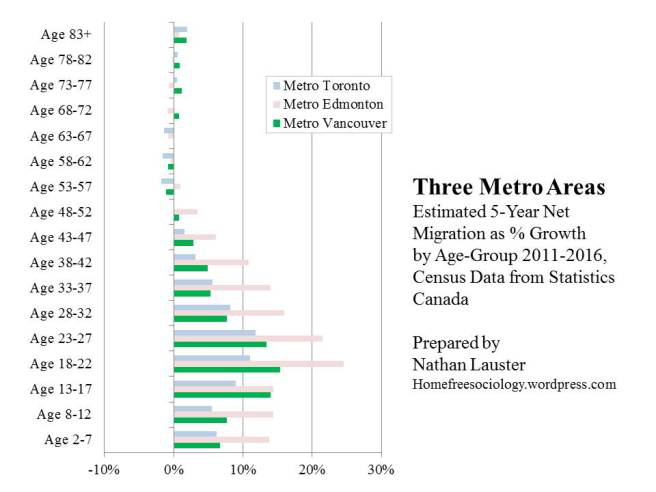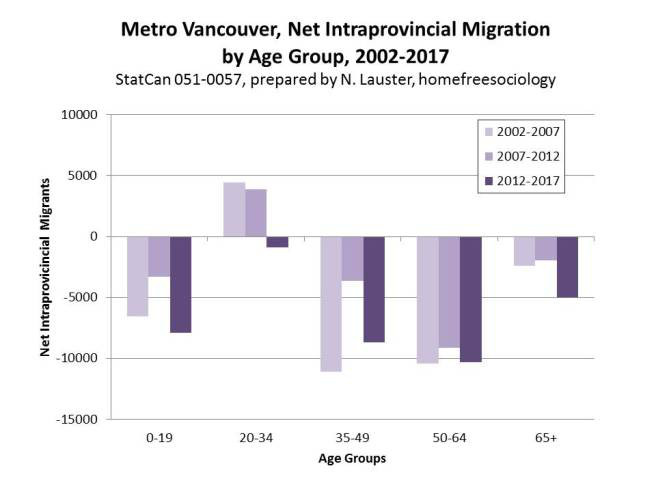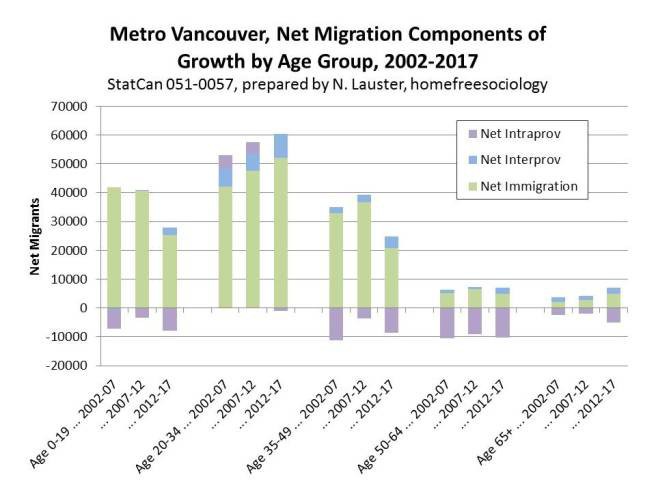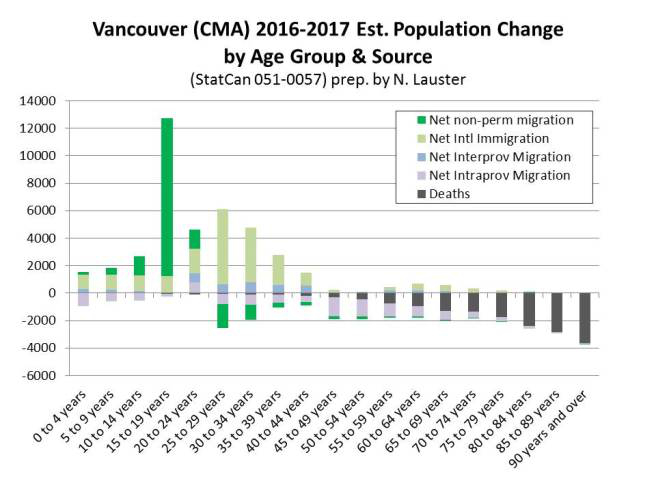We are plagued with zombie factoids. You can kill them over and over again with evidence of their falsehood, but they keep resurrecting and coming back because they fit prevalent narratives.
The “fleeing millennial” is one of Vancouver’s key zombie factoids. The basic idea is that the city is getting so expensive that it’s driving out millennials. Vancouver is sacrificing its own future! The detritus of uneaten avocado toast will ruin our tidy streets! (I kid, that’s what seagulls are for.)
The problem with this factoid is that it’s false.
Behold, the lifeblood of Vancouver isn’t leaving!

I’ve previously attempted to kill the “fleeing millennial” factoid idea here, here, here and here. But it keeps coming back. It’s a zombie; undead and on the lookout for brains to eat.
The factoid has also been used (especially when it works in conjunction with the outward tide of interprovincial migration) to suggest that unaffordability in Vancouver, particularly of single-family houses, is driving everyone away. More often, the stories are anecdotal: a doctor leaves in a huff; a public relations professional moves to Squamish; a Calgary management consultant refuses an offer to move to Vancouver. But sometimes arguments are made, and vague statistics leveraged, suggesting that housing prices are pushing everyone out of Vancouver.
As factoids go, this one highlights a real and pressing problem: the local unaffordability of housing. But it does so in a misleading and harmful fashion. It’s misleading because there is no data anywhere suggesting that we’re selectively losing people in the age groups reasonably corresponding to millennials. It’s harmful because every time it reappears, the fine print reveals that it necessarily valorizes some millennials over others.
The most recent resurrection of the fleeing millennial zombie factoid arrives via the folks at Better Dwelling, running their headline “See Ya! Local Millennials Are Abandoning Toronto and Vancouver.”
The valorization of a particular set of millennials receives a nod in the headline: we’re dealing with “local” millennials. Within the body of the piece, this is fleshed out: we’re dealing with intraprovincial migration patterns, between Metro Vancouver and other parts of B.C., and between Metro Toronto and other parts of Ontario.
Intraprovincial migration leaves out international immigration and interprovincial migration, the two other main components of migration overall (as described by Statistics Canada). Given that Toronto and Vancouver are Canada’s premier gateway cities, this is a pretty big oversight! Immigrants flood into these cities, with some staying while others move on to other parts of Canada.
I’ll come back to this problem, but let’s start with Better Dwelling’s focus, on intraprovincial migration. Can I replicate their findings drawing upon Statistics Canada components of population change data? Nope.

I can get the same pattern, but not the same numbers. Here’s what I get looking at intraprovincial migration (summing net change for the years and age groups covered and adding the historical context from 2002-2007 just because it’s there!) This worries me a bit, and I asked Better Dwelling for clarification, but they have yet to respond (I also checked my numbers with the ever-helpful Jens von Bergmann over at MountainMath, who also couldn’t reproduce Better Dwelling’s numbers).
At any rate, the pattern is the same. But the pattern is misleading. After all, we’re only looking at a single component of migration. What happens if we add them all in?

Wow. That looks quite different! If anything, net migration from millennials (age 20-34) is soaring to all new heights in the latest five-year period estimation. It’s just that intraprovincial migration has a slight drag on this pattern (compared to a more steady drag across other age groups). What to make of this?
As a gateway city, Vancouver’s population growth is driven first and foremost by international migration. Both interprovincial and intraprovincial migration play a role at the margins. We are definitely not losing millennials.
But what about the claim that we’re losing “local” millennials?
It’s a weird claim. It’s likely the case that many of the millennials showing up as international migrants in one period might later show up as interprovincial or intraprovincial migrants in another.
Ideally that’s what gateway cities do: take in huge numbers of migrants, keep some, and send others toward the broader set of communities in the province (and the rest of Canada) looking for workers and growth. Personally, I happen to know at least one Chinese immigrant to Vancouver now working and residing in Kelowna.
It might be fun to break down intraprovincial migration by place of birth or the like, but absent that kind of careful analysis there’s no reason to imagine intraprovincial migration patterns identify “locals” or are uniquely informative about the state of millennials in Vancouver or Toronto.
Vancouver has at least 99 problems associated with housing affordability, but losing our lifeblood ain’t one.
As a methodological aside, it also feels a little odd to sum up the components of growth from Statistics Canada models in the time periods specified without acknowledging that they’re calibrated to the census years (2001, 2006, 2011, 2016). So 2012-2017 provides an estimated breakdown of components of change drawn from the combination of a 2011-2016 comparison with various sources of administrative data. The 2016-2017 estimations are especially subject to change! Still, it’s neat to see how Stats Can does this work. As a bonus, here’s what you get in terms of Statistics Canada’s model of population change by age group in Metro Vancouver moving forward from the Census year (2016) to the next (2017), but setting births aside.

What really jumps out is the contribution non-permanent residents are making! They don’t show up in net migration figures here, but wow! Look at how much they’re contributing to growth, especially in the late teens. See the CMHC’s write-up about the effects non-permanent residents might be having on housing demand, but keep in mind that many will transform (like I did) into permanent residents.
And in the meantime: watch out for zombies! Don’t let them near your brains! ![]()
Read more: Local Economy, Housing















Tyee Commenting Guidelines
Comments that violate guidelines risk being deleted, and violations may result in a temporary or permanent user ban. Maintain the spirit of good conversation to stay in the discussion.
*Please note The Tyee is not a forum for spreading misinformation about COVID-19, denying its existence or minimizing its risk to public health.
Do:
Do not: